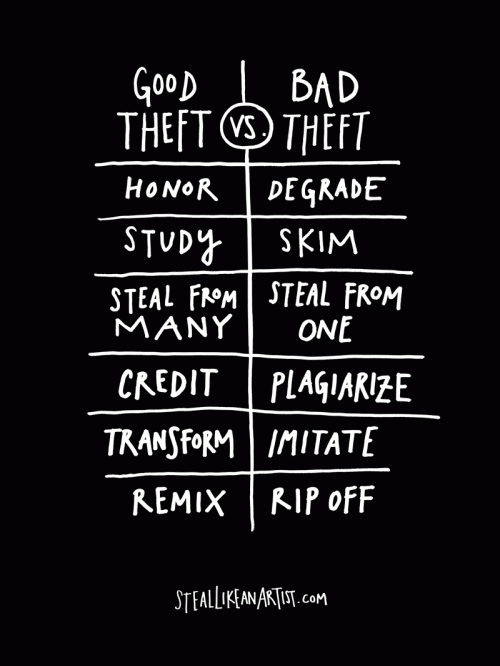CTRL+C: The Art of Copying Your Way to Originality
Posted by: Calvin ChoppIt was a year or so after I’d graduated from college and I was ready to make my mark professionally on the world. I was fortunate and found a job in my chosen career path of digital design and development. I was excited to work my way up the vocational ladder.
Along with the excitement was a building sense of stress as I felt the need to create something original for our clients every time a project came across my desk. I didn’t want anything I created to look like something anyone had seen before. I was going to be the one to start design trends.
I joined communities like Dribbble, Behance, and Instagram where I’d share work that I was doing, and to find others that inspired or I’d look up to, hoping to one day achieve similar success with my designs. Despite all that, there was always an underlying feeling of stress and anxiety around the need to be innovative and original with everything that I laid my fingers on.
It wasn’t long before I felt like I was treading water in my work with only the creative, original ideas I brought to the table (seemingly few and far between) keeping me afloat. The stress of this process was completely counterproductive to what I was trying to achieve. In the name of presenting something original within budgetary and timeframe constraints, I was creating my own creative blocks, and finding it difficult to produce products for our clients that achieved a desired goal within a desired timeframe.
So, I want to explore what it is that drives us toward creativity, why we get creative blocks on original ideas, and how practicing good copying and mimicry can help us unleash creative potential and create better products for our customers.
What do you mean I should copy something? That’s wrong!
You’re right! Plagiarism is wrong, and not what I’m advocating. Originality and creativity is something we build up, and is a reflection of our personality and experiences, which we bake into the things we make. It’s not surprising to me that the concept of copying is so taboo, because the line we walk between copying and plagiarism can often seem very thin.
That said, I think that it’s good for us to look at the art of copying and consider what it helps us do, when and how it should be practiced, and how we can use these techniques to improve our skills as designers.
Copying is one of the fundamental ways we learn.
Humans are hardwired to mimic and copy. It’s one of the fundamental building blocks of learning. A baby, unable to communicate any other way, observes and learns how to accomplish many basic life skills by copying what those around them do. Speech patterns, first steps, and how to twist a door knob are all patterns that are developed through observation and mimicry. As we continue to grow, cultural norms, behavioral patterns and routines are developed largely from observation of those we associate ourselves with. (Face it, at some point in your life you will think something like “I really am becoming my father/mother!”). It shouldn’t come as a surprise that, if our brains are hardwired with learning patterns such as this, that there would be professional ways that we could apply these same processes.
For an early example of this, let’s look at the ancient city of Alexandria.

The ancient city of Alexandria was a hub of commerce, culture, and economic prosperity. From the time the city was founded, it was imbued with the spirit of curiosity. The founders of the city were greatly influenced by Aristotle, his philosophy based on observation and data collection, as well as logical reasoning, being driving factors for the city’s development.
Being a port city, commerce from all over the world came through its harbors. For a ship to dock in Alexandria, they were required by law to give not money or other treasures, but to turn over any book they carried. The books were then copied (by hand), and a copy of their books were given back to the owners. The debate over how many books were in the total collection still is disputed, but half a million books is a typical estimate. This mass collection of books would become the Great Library of Alexandria.
As a result of this tedious process of gathering and copying the books, the city amassed an incredible trove of knowledge of the experiences of other people, which played a large part to Alexandria making huge advancements in the ancient world, and becoming one of the central hubs of learning and innovation for the Roman Empire.
For the leaders of Alexandria, the process of copying and studying the work and progress of many led to further innovation and ideas. Copying, mimicry, and learning are the soil in the garden of creativity. Our own experiences and personality water the seeds of innovation.
Cartoonist Lynda Berry wrote:
“I think copying someone’s work is the fastest way to learn certain things about drawing and line. It’s funny how there is such a taboo against it. I learned everything from just copying other people’s work.”
By casting a wide net of those who we copy and observe, we create a greater opportunity to, like the city of Alexandria, use that knowledge to guide us to better, more original ideas.

Using copying & mimicry for professional development: learn the mindset
When we look to copy in a productive way professionally, our goal isn’t to plagiarize. (Can’t say that enough.) Our goal is to see through the eyes of the designers and creators we see doing what they do well. It’s to get a better understanding of the mindset that creates successful products.
Search out sites, applications or other digital experiences that have been successful, and be curious. Can what made those products successful be applied to your customer in some way? How might you use those successful approaches or strategies that you’ve observed within the projects that you’re working on?
Free yourself from the pressure of instant-originality

Original ideas don’t necessarily mean better. There’s the obvious pride in knowing that you were the first to come up with an idea, but especially in UX and digital products, we need to weigh the cost of doing something completely new against how the user will actually interact with what we’re creating, as well as the client’s budget and timeframe for production.
There’s a reason that the majority of ecommerce experiences follow a similar general pattern, or an app’s onboarding experience follows similar steps. Users are accustomed to a certain experience, and introducing changes to that experience, unless measured and well-vetted, may have negative [expensive] repercussions.
Instead of stressing about creating a completely original approach to your client’s current problem, look for ways to leverage what you’ve observed, what you know and are capable of doing, to formulate a plan. Often, innovation and originality is discovered through this process regardless, as opposed to a conscious choice to search it out. Take time to set a project up to allow for scalability into originality. (Stay posted for an upcoming discussion on being product focused, as opposed to simply project focused. It’s applicable here.)
Focus on authenticity, less on originality.
When originality is replaced as our focus by observation through copying and mimicry how I’ve described, we bring something else into our work—authenticity. Focus on creating authentic products that solve problems for your customer, and by doing so, give yourself the roadmap to reach new ideas. Look at how it’s been done before. Copy it, tear it down, and do it again, over and over and over again, until you start to see your own take on that idea being shaped based on your collective observations.
Before you know it, the creativity and innovation that used to stress you out will start to show organically through the ways that you approach your projects, and the products and solutions created for your clients will only benefit.